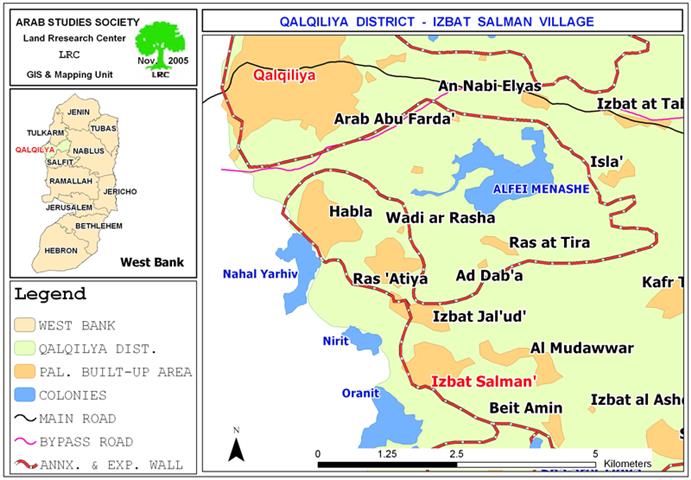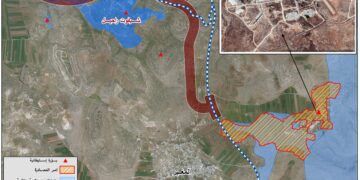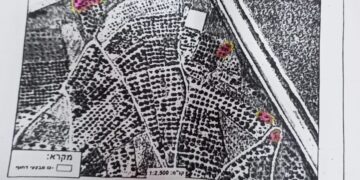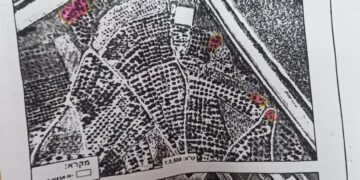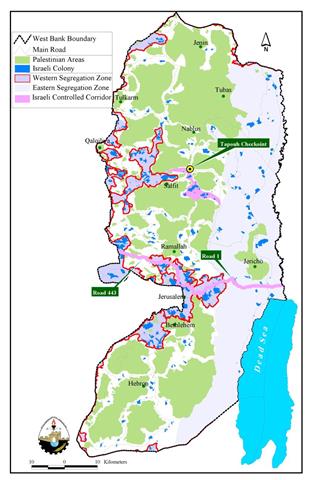Location, population and area:
The village of Izbat Salman is located 6 km to the south of Qalqiliya city. The history of the village represents an example of the continued dispossession and displacement at the hands of the Israeli Occupation against the Palestinian people and land. For, its people were forcibly removed out of their homes and lands from the already demolished village of Azaqur in 1950. Afterwards, citizens of Azaqur became refugees on the eastern side of the Armistice Line opposite to their original village and started to form a new community under the name of Izbat Salman. The lands they were dismissed to were part of the extended agricultural lands of Azaqur village. An Israeli settlement carrying the name of Nirit was built on the ruins of the demolished village of Azaqur on the western side of the Armistice Line. See map 1: location of Izbat Salman
Ever since Israel Occupied the West Bank and Gaza Strip in 1967, people of Izbat Salman village whose population totals today 800 have been suffering from the continuous Israeli harassments and aggressions affecting all facets of life, particularly, regular detentions, confiscation of lands, imposition of curfews, limitations on building and construction and prevention of movement.
After the year 2000, the situation became even worse, especially following the construction of the Segregation Wall and the dismissal of the village's workforce from their workplaces inside Israel. Now, 85 % of inhabitants depend on agriculture as a main source of income since the village has fertile lands suitable for seasonal crop cultivation as well as citrus and olive trees.
The village and the Wall:
After embarking on the establishment of the Segregation Wall at the beginning of 2003, more than 270 dunums of fertile lands have been confiscated for this purpose. The sections of the Wall in Izbat Salman were completed by the end of 2003 at a length of 3.8 km and a width of 50-100 meter. In certain parts, the Wall distances only 12 meters from the village houses which have had tremendous effect on the life of their occupants during the building process as a result of the accumulation of soil and dirt in the vicinity of houses, in addition to huge sounds of explosions.
The following are the most effective impacts of Wall construction on the village:
1. Separating more than 3000 dunums out of the total of 4500 dunums (66%) behind the Wall. The separated lands are classified as the most fertile and productive lands in the village encompassing irrigated crops and rain fed cultivation such as cereals.
2. Devastating more than 270 dunums under the path of the Wall resulting in the uprooting of 15000 trees, mostly olive;
3. Destroying two water reservoirs, 200 each, which were used for irrigation;
4. Raising the levels of un-employment to 70% due to loosing jobs inside Israel;
5. Destroying at least 15 dunums of lands covered with agricultural green houses located on the other side of the Wall- in the separated areas;
6. Separating two artisan wells: the first is 200 meters away from the Wall with production capacity of 75M3/hour; the second is 500 meters away from the Wall with production capacity of 100M3/hour. This measure deprives the village of its water resources and causes severe water shortages for both agricultural and domestic uses.
7. Preventing any territorial expansion for the village towards the south and the north and consequently limiting natural growth in these two directions;
8. Establishing two Wall gates for the village farmers: the first one in Izabt Jal'ud to the north of the village and the second in Beit Imin south east of the village. These two gates are located at the distance of three km from Izbat Salman.
9. Procrastinating and/or refusing the issuance of passing permits for Palestinian farmers and land owners from Izbat Salman willing to access their lands separated by the wall. More than half of the applications have been turned down by the Israeli military.
Expropriation of lands behind the Wall:
In June, 2004, the central commander of the Israeli army issued a military order stipulating the confiscation of 300 dunums from the village lands already separated behind the Wall. The confiscated lands which are located in the areas of Qatayen An Ni'aj and Al Maqat'i were claimed to be taken for security purposes. 60 dunums of these lands are cultivated with olive trees while the remaining 240 dunums are cultivated with ground crops. As a result of the Israeli action, 40 Palestinian families have lost their only source of livelihood.
The real reason behind the aforementioned confiscation, according to Palestinians, is to enlarge the nearby settlement of Nirit from the north eastern side upon pressure exercised by the settlers of Nirit taking advantage of the current situation and the establishment of the Wall.
Affected people presented an appeal to local and international humanitarian organizations, Israeli BTselem centre, the Palestinian Legislative Council, Palestinian ministry of Local Rule and International Committee of the Red Cross, but, yet to no avail.
Despite this, the Israeli bulldozers started to devastate the targeted lands at the beginning of September, 2004, uprooting hundreds of trees and laying down the infrastructure for the settlement expansion. The whole infrastructure works were completed by the beginning of March, 2005.
Prepared by
The Land Research Center
LRC


